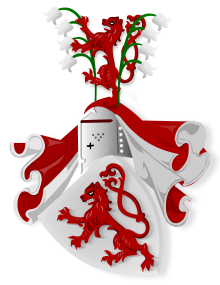| Limburg-Hohenlimburg-Broich | |
|---|---|
 Coat of Arms | |
| Parent house | Ezzonen, House of Berg |
| Country | Holy Roman Empire |
| Founded | 13th century as Counts of Limburg (Lenne) |
| Founder | Diederick I, Count of Limburg |
| Final ruler | Johan II, Count of Limburg-Hohenlimburg-Broich |
| Titles | German Imperial Counts |
| Estate(s) | County of Berg, Altena, Isenberg, County of Limburg, Broich. |
The house of Limburg Hohenlimburg (later Limburg-Hohenlimburg-Broich) took its name in the 12th century from the county of Limburg on the river Lenne in today's Germany. After Diederick of Isenberg had claimed part of the former property of his father Frederik of Isenberg with the help of uncle Duke Hendrik of Limburg, he built the Hohenlimburg castle on the river Lenne. At fifty years of age, his third son Everhart, closest descendant of the original holder, succeeded him in the county. Mentioned count, in original kept charters, since 1276 together with his father. It was clear that the future male-line primogeniture was granted. Everhard is the ancestor of the family branch of the counts of Limburg Hohenlimburg and Broich. His first brother Henry (1241 -1243) died young and second Johan (1247–1277), died at the age of thirty, left three children. Johan is the ancestor of the house Lords of Limburg Stirum. The Counts of Limburg Hohenlimburg and Broich were not count by name with a late 17th century certified title but actually ruled the county of Limburg-Lenne since the 13th century, until the first quarter of the 16th century. The last count Johan (1464–1511) who had no descendants of his own. None of his only two male relatives, cousins Diederick and Adolf of Limburg, sons of his former godfather Johan of Limburg (1421–1472), had inheritance rights, as explained below. To prevent the family of his former wife Von Neuenahr from taking the county, Count Johan adopted his cousin Irmgard of Sayn at her marriage to Winrich of Daun. She and her husband inherited the county.